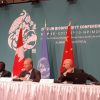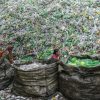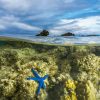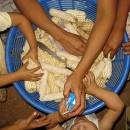Saturday, June 10, 2023
News and Views from the Global South
Biodiversity

Biodiversity Agreement Historic But Difficult to Implement
The pillar coral (Dendrogyra cylindrus), which takes its name from its shape, is found throughout the Caribbean Sea, but its population has declined by more than 80 percent since 1990. As a result, the International Union for Conservation of Nature (IUCN) has listed it as "critically endangered" due to the effects of the human-induced climate crisis.
Gender Target at COP15: Russia’s Single Word Objection Holds Up Process
Since the beginning of the high-level segment, tensions have been steadily rising at the 15th meeting of the conference of the parties to the UN Convention on Biological Diversity (CBD COP15) among all participants, including members of country delegation teams, NGOs, observers, monitors, and media. At the press events held daily at the media center and various other events in the Montreal Convention Center, an outburst of anger and frustration have become a common sight.
Tracking the Impact of Science on Biodiversity Conservation
Billy Offland (21), a British sustainability student, went on a two-year 'World Conservation Journey' to bring attention to the biodiversity crisis as the world seeks a deal to protect nature.
Digital Treatment of Genetic Resources Shakes Up COP15
In addition to its nutritional properties, quinoa, an ancestral grain from the Andes, also has cosmetic uses, as stated by the resource use and benefit-sharing permit ABSCH-IRCC-PE-261033-1 awarded in February to a private individual under a 15-month commercial use contract.
COP15: Impact of Mega Infrastructure Projects on Biodiversity Stay Off-Radar
As the COP entered its crucial second week, negotiations are intensifying now. A slew of new contact groups – meeting mostly behind closed doors – are discussing the minutest details of the Global Biodiversity Framework and the contentious issues within or around it, such as Digital Sequencing Information, Access, and Benefit Sharing. The core aim of all these groups is to talk and resolve all issues and produce a draft treaty that will be acceptable to all parties.
COP15: Unsustainable Infrastructure Threatens Biodiversity
Created in 2016, the Mexican Caribbean Biosphere Reserve (MCBR) hosts 1900 species of animals and plants and contains half of the Mesoamerican Barrier Reef System, the second largest in the world after Australia's Great Barrier Reef.
Experts Seek Appropriate Circular Solutions to Plastic Pollution
Experts agree that African economies need to develop innovative approaches to deal with plastic production, which is set to double in 20 years – adversely impacting rural communities.
Africa Fights Back Against Wildlife Poachers, but Drought is Devastating
Elephant populations are starting to recover in parts of Africa as law enforcement agencies and local communities turn the tide in their long-running battle against wildlife poachers and traffickers.
As COP15 Begins, Biodiversity’s ‘Paris Moment’ Looks a Distant Dream
The long-awaited 15th Convention of United Nations Biological Diversity (CBD COP15) finally started this week in Montreal, Canada. After four years of intense negotiations and delays caused by the COVID-19 pandemic, nations have gathered again for the final round of talks before adopting a new global treaty – the post-2020 Global Biodiversity Framework (GBF).
COP15: ‘Super Reefs’ Offer Hope for Ocean Recovery Ahead of Biodiversity Summit
Delegates from more than 190 countries are donning thick coats and winter boots to attend the long-delayed UN biodiversity summit in Montreal, Canada—the land of caribou, beluga whales and wolverines.
COP15: Shift in Societal Values Needed to Address Biodiversity Loss
Policymakers were encouraged to look at the economic and social aspects with the environmental elements of biodiversity losses to meet the Global Biodiversity Framework (GBF) targets.
COP15: We are Losing Nature – Biodiversity – at the Fastest Rate in Human History
While climate change dominates the environmental headlines, quieter, startling changes are taking place in nature across the planet – whether in forests, oceans, deserts, rural landscapes, cities and other places where nature is found.COP15: Biodiversity Conservation in the Face of Growing Economies
Dating back to the 16th Century, the face of biodiversity conservation has taken several tolls and twists- evolving from an era of preservation to conservation- down to conservation and sustainable utilisation of natural resources.
Iconic Atlantic Bluefin Tuna in Less Troubled Waters
The Atlantic bluefin tuna is among the largest, fastest, and most beautifully colored of all the world’s fish species. They can measure more than 10 feet in length, weigh over 700 kilograms, and can live longer than 30 years. With their metallic blue coloring on top and shimmering silver-white on the bottom, the giant bony fish is a sight to behold.
Putting Nature on a Quantifiable, Ambitious Path to Recovery
Up to 1 million species are threatened with extinction – many within decades – this includes nearly one-third of reef-forming corals, shark relatives, and marine mammals. Half of agricultural expansion occurs at the expense of forests, and 85% of wetlands that were present at the beginning of the 18th century had been lost by the year 2000, with the loss of wetlands considered to be happening three times faster, in percentage terms, than forest loss.
For this Caribbean Island, Ozone Protection is a Year-Round Mission
For countries across the globe, September 16th is a day to reflect on progress in protecting the ozone layer. The United Nations designated day for the preservation of the ozone layer is marked by speeches, and educational and social media campaigns.
Lessons from Niyamgiri Movement’s Success to Protect an Indigenous Sacred Mountain
The Dongria Kondhs say they are the descendants of Niramraja, a mythical god-king who is believed to have created the Niyamgiri range of hills in Odisha, an eastern Indian state on the Bay of Bengal.
COP 15: It’s Time to Decide on a Future
It is no secret that humankind’s past actions have accelerated the deterioration of ecosystems, negatively impacting our economies, societies, health, and cultures. It is estimated that humans have altered over 97% of ecosystems worldwide, to date. One million species are currently threatened with extinction (IPBES). The writing on the wall is clear. Our planet is in crisis. The sobering reality is that if we continue on our current trajectory, biodiversity and the services it provides will continue to decline, jeopardizing the achievement of the Sustainable Development Goals and our lives as we know them. The decline in biodiversity is expected to further accelerate unless effective action is taken to address the underlying causes of biodiversity loss. These causes are often justified by societal values, norms and behaviors. Some examples include unsustainable production and consumption patterns, human population dynamics and trends, and technological innovation patterns.
Mexican Environmental Prosecutor’s Office Dodges Charges against Mayan Train
A beige line slashes its way through the Mayan jungle near the municipality of Izamal in the southeastern Mexican state of Yucatán. It is section 3, 172 kilometers long, of the Mayan Train (TM), the most important megaproject of President Andrés Manuel López Obrador's administration.
Land Ownership Model Is Restoring Biodiversity, Empowering Communities in Kenya
When Mara Siana Conservancy came into operation in 2016, there was a single zebra and a topi (antelope) in the valley just outside the Maasai Mara National Reserve in Kenya. The valley was also host to fewer than 150 elephants and 200 buffalos.
Broken Relationship with Nature Exposed as Global Wildlife Population Plummets
Home to a variety of iconic and rare animal and plant species, freshwater lakes, rivers, waterfalls, and the expansive Indian Ocean coastline, Kenya’s place as a biodiversity hotspot has never been in doubt.« Previous Page — Next Page »











